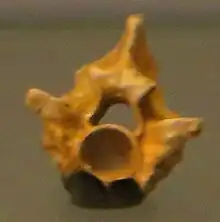Palaeopython
Palaeopython is an extinct genus of snake from the Eocene of Europe. The genus has been used to refer to large Western and Central European snake vertebrae from the Eocene. P. cadurcensis (the type species, originally named as a species of Python by Henri Filhol in 1877) and the tentatively-referred "P." neglectus (named by Alphonse Trémeau de Rochebrune in 1884) originate from France; P. ceciliensis (named by Ben Barnes in 1927) originates from Germany; and P. helveticus (named by Georgios Georgalis & Torsten Scheyer in 2019) originates from Switzerland.[1] A species known from multiple well-preserved specimens found in the Messel Pit of Germany, P. fischeri, was named by Stephan Schaal in 2004, but examination of the genus showed that it represented a distinct lineage; it was renamed Eoconstrictor fischeri in 2020 by Agustín Scanferla and Krister T. Smith.[2] Another species from France, P. filholii (named by Rochebrune in 1880), was moved to the genus Phosphoroboa in 2021 by Georgalis, Márton Rabi, and Smith.[3] An additional species, P. sardus, was described in 1901 by Alessandro Portis from the Middle Miocene of Monte Albu (Sardinia, Italy). However, a reevaluation of the holotype specimen of this species revealed it to actually belong to an indeterminate acanthomorph fish.[4]
| Palaeopython Temporal range: Eocene, ~ | |
|---|---|
 | |
| Vertebra of Palaeopython helveticus | |
| Scientific classification | |
| Domain: | Eukaryota |
| Kingdom: | Animalia |
| Phylum: | Chordata |
| Class: | Reptilia |
| Order: | Squamata |
| Suborder: | Serpentes |
| Family: | Boidae |
| Genus: | †Palaeopython Rochebrune, 1880 |
| Species | |
| |
References
- Georgalis, G.L.; Scheyer, T.M. (2019). "A new species of Palaeopython (Serpentes) and other extinct squamates from the Eocene of Dielsdorf (Zurich, Switzerland)" (PDF). Swiss Journal of Geosciences. 112 (2–3): 383–417. doi:10.1007/s00015-019-00341-6. S2CID 195374710.
- Scanferla, A.; Smith, K.T. (2020). "Exquisitely Preserved Fossil Snakes of Messel: Insight into the Evolution, Biogeography, Habitat Preferences and Sensory Ecology of Early Boas". Diversity. 12 (3): 100. doi:10.3390/d12030100.
- Georgalis, G.L.; Rabi, M.; Smith, K.T. (2021). "Taxonomic revision of the snakes of the genera Palaeopython and Paleryx (Serpentes, Constrictores) from the Paleogene of Europe". Swiss Journal of Palaeontology. 140: 18. doi:10.1186/s13358-021-00224-0.
- Delfino, M.; Zoboli, D.; Carnevale, G.; Pillola, G.L. (2014). "The rediscovered holotype of Palaeopython sardus Portis, 1901 from the Miocene of Sardinia belongs to a fish, not to a snake". Bollettino della Società Paleontologica Italiana. 53 (2): 89–92.